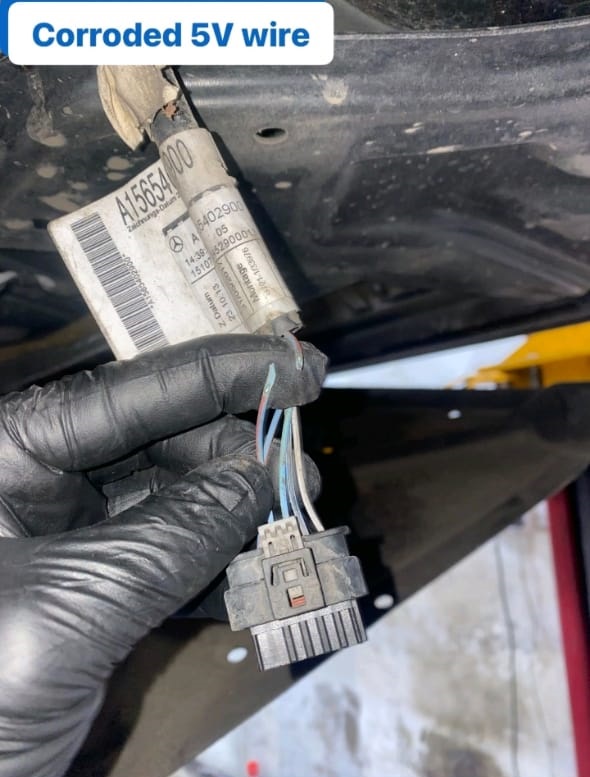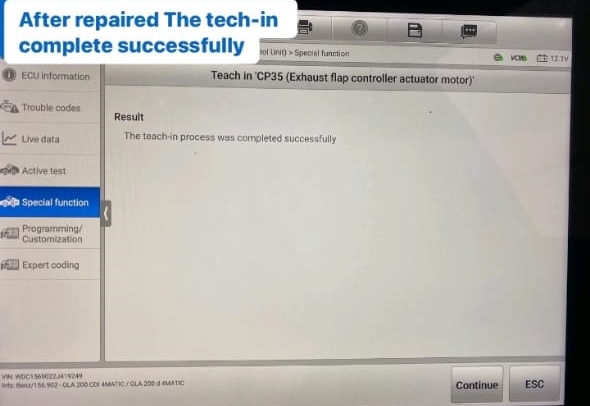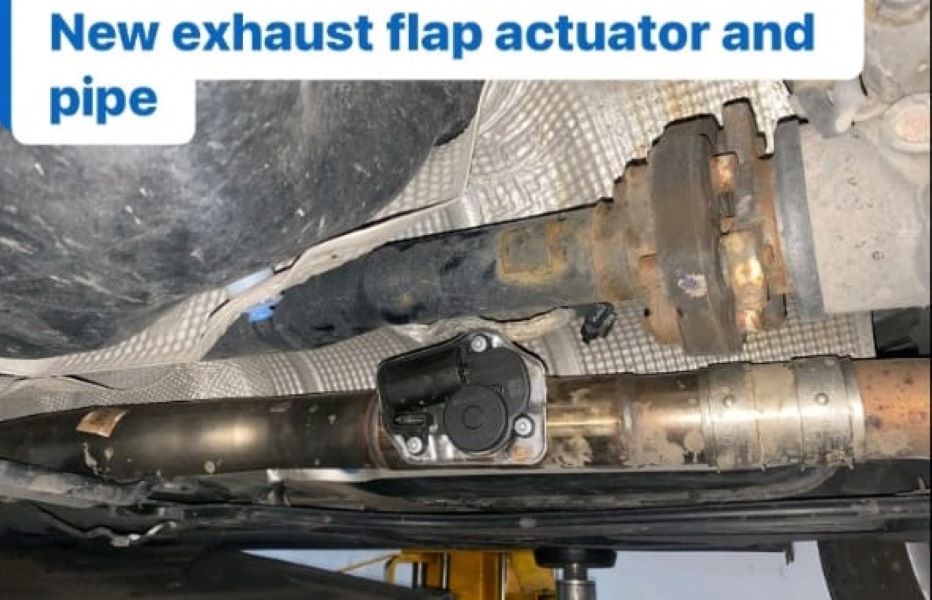Table of Contents
Case Study: Loss of Power in Car , Mercedes-Benz GLA with M270 Engine
When a Mercedes-Benz suddenly loses power or enters limp mode, it can feel alarming especially when the Check Engine Light is on. Many drivers assume the issue lies in the intake system, turbocharger, or exhaust components, but as this real-world case shows, electrical faults can also be the hidden culprit.
In this case study, we’ll walk through how a Mercedes-Benz GLA 156 equipped with the M270 engine experienced severe power loss due to a corroded wire in the exhaust flap actuator circuit, despite multiple parts already being replaced by another workshop.
Customer Complaint
The customer brought in their Mercedes-Benz GLA 180 after visiting another repair shop. The vehicle had persistent issues with:
- – Loss of power during acceleration
- – Activation of limp mode
- – Warning light related to exhaust system performance
Despite previous repairs, the car continued to underperform, prompting a second diagnostic opinion.
Step 1: Reviewing Previous Repairs
According to the repair history, the previous workshop had already:
- – Replaced the intake manifold
- – Replaced the exhaust flap actuator
However, the power loss and limp mode symptoms persisted. This immediately suggested a deeper issue potentially electrical or control-related, rather than mechanical.
Step 2: Confirming the Complaint
The technician began with a visual inspection and active function tests:
- – The exhaust flap actuator showed no response during activation.
- – The active test via AUTEL failed to trigger movement.
- – The vehicle remained in limp mode, confirming an actuator communication or power issue.
These findings ruled out a simple mechanical jam and pointed toward an electrical or signal problem.

Step 3: Electrical Diagnosis
Understanding the actuator’s control path was key. The Powertrain Control Module (PTCU) manages both:
- – The exhaust flap actuator
- – The low-pressure EGR (exhaust gas recirculation) system
Using Mercedes Star Finder wiring diagrams, the technician traced the actuator’s 5V reference line and discovered the supply voltage was missing.
This suggested a broken wire, short, or corroded connection interrupting the control signal.


Step 4: Finding the Root Cause
Further inspection under the vehicle revealed the true problem:
- – A corroded wire located near the exhaust system.
- – The corrosion disrupted the 5V reference signal feeding the exhaust flap actuator.
This small but critical fault caused the actuator to fail electrically triggering limp mode and reducing engine power.

Step 5: The Repair Process
Instead of replacing more parts unnecessarily, the technician performed a precise repair:
- 1. Cut and cleaned the corroded wire section.
- 2. Spliced and soldered the damaged wire to restore full continuity.
- 3. Insulated and secured the wiring to prevent heat and moisture exposure.
- 4. Cleared fault codes and performed a full function test on the exhaust flap actuator.

After confirming proper function, a final road test was performed to verify the power restoration.
Results
=> No new parts replaced unnecessary costs avoided.
=> Exhaust flap actuator fully operational.
=> Limp mode cleared and engine power fully restored.
=> No fault codes remaining in the drivetrain control unit.
The repair confirmed that a simple corroded wire was the root cause behind the persistent loss of power in car a problem that could easily have been misdiagnosed as a costly sensor or actuator failure.

Key Lessons for Technicians
This case study reinforces why structured diagnostics are vital when resolving Check Engine Light and loss of power issues in modern Mercedes-Benz vehicles.
- – Always verify voltage supply and continuity before replacing actuators.
- – Use OEM wiring diagrams (Star Finder) to trace signal paths.
- – Inspect underbody harnesses exposed to heat, moisture, or salt corrosion.
- – Run active tests and live data analysis before confirming the fault source.
For more diagnostic examples like this, see our full guide:
Mercedes Check Engine Light: Complete Troubleshooting Hub featuring real-world Mercedes case studies on power loss, sensor faults, and limp mode recovery.
FAQs: Loss of Power in Car
Why is my car losing power when driving?
Your Mercedes may lose power while driving due to air, fuel, or exhaust system problems. Common causes include:
- – Blocked exhaust components such as a clogged DPF or a malfunctioning exhaust flap.
- – Faulty sensors, including the MAF (Mass Air Flow) or throttle position sensor.
- – Fuel delivery issues, such as a weak fuel pump or restricted fuel filter.
- – Electrical wiring faults that interrupt actuator or sensor signals.
- – Transmission or turbocharger malfunctions that reduce engine output.
In the Mercedes-Benz GLA case study, a corroded wire near the exhaust flap actuator was the cause of the power loss, highlighting why electrical inspection is just as important as mechanical checks.
How do you fix engine power loss?
Fixing engine power loss starts with identifying the root cause using a structured diagnostic approach:
- 1. Scan for fault codes using a STAR or OBD-II diagnostic tool.
- 2. Inspect the exhaust system for blockages or actuator faults.
- 3. Check the fuel system for proper pump pressure and filter condition.
- 4. Test electrical continuity on wiring harnesses and sensor circuits.
- 5. Examine the air intake system for obstructions or faulty airflow sensors.
- 6. Verify transmission performance, as slipping gears can mimic engine power loss.
In our case, repairing a corroded wire restored full power proving that accurate electrical testing can prevent unnecessary part replacements.
Is it okay to drive with engine power reduced?
It’s not recommended to drive when your car displays a “Reduced Engine Power” warning or enters limp mode. This safety function limits performance to prevent engine or transmission damage.
Driving in this condition can lead to:
- – Overheating or misfiring, causing engine strain.
- – Poor fuel economy and increased emissions.
- – Safety risks when overtaking or merging onto highways.
If you experience reduced power, have your vehicle diagnosed immediately by a certified Mercedes technician to avoid further damage.
What should a driver do if the engine power is lower than normal?
If your Mercedes feels underpowered, follow these steps:
- – Pull over safely and assess whether the car is in limp mode.
- – Check for warning lights, such as the Check Engine or Exhaust System message.
- – Inspect visible components, like fluid levels or disconnected hoses.
- – Restart the engine, as this can sometimes reset temporary faults.
- – Drive cautiously and avoid high speeds or steep inclines.
- – Visit a workshop to perform a full diagnostic scan and inspect for wiring or sensor issues.
A proactive approach not only prevents costly repairs but also ensures your Mercedes operates safely and efficiently.
Author
Written by: Mercedes Expert
Automotive Technical Trainer & Mercedes-Benz Diagnostic Specialist
With years of hands-on experience repairing and diagnosing Mercedes-Benz vehicles, specializes in case-study-based troubleshooting guides that blend workshop accuracy with educational clarity.
Last Updated: November 2025
— Salim, Mercedes Expert
Independent specialist in Mercedes-Benz diagnostics, CAN Bus analysis, troubleshooting case studies, and EV systems.







Leave a Reply